非标准货物运输单元系固-货物积载与系固安全操作规则.
- 格式:ppt
- 大小:351.00 KB
- 文档页数:8
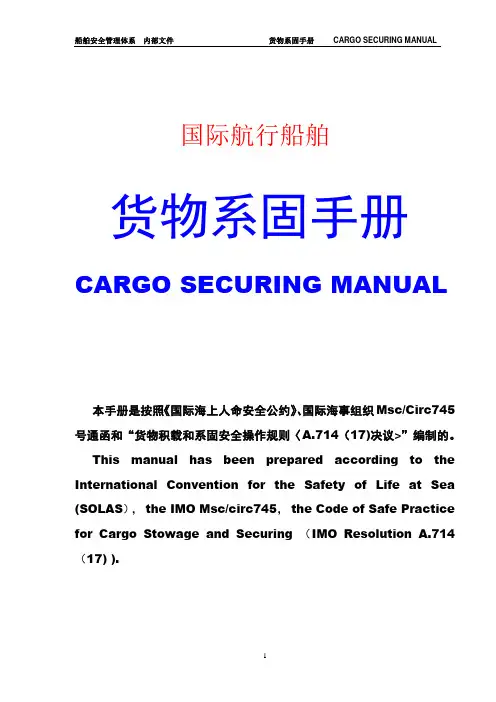
国际航行船舶货物系固手册CARGO SECURING MANUAL本手册是按照《国际海上人命安全公约》、国际海事组织Msc/Circ745号通函和“货物积载和系固安全操作规则〈A.714(17)决议>”编制的。
This manual has been prepared according to the International Convention for the Safety of Life at Sea (SOLAS),the IMO Msc/circ745,the Code of Safe Practice for Cargo Stowage and Securing (IMO Resolution A.714(17) ).序言(PREAMBLE)本手册是按照1974年《国际海上人命安全公约》、国际海事组织第Msc/Circ745号通函、国际海事组织决议A.714(17)以及“货物积载和系固安全操作规则”编制的。
This manual has been prepared according to the International Convention for the Safety of Life at Sea , 1974(SOLAS)1994 amendment,the IMO Msc/circ745,the Code of Safe Practice for Cargo Stowage and Securing (IMO Resolution A。
714(17))。
本手册应永久保留在船上,以便船级社的验船师、港口国检查的官员以及其他有关人员的随时检查。
The manual shall always be kept on board and available for inspection by class surveyors ,port/flag state inspectors and others to whom it may concern。
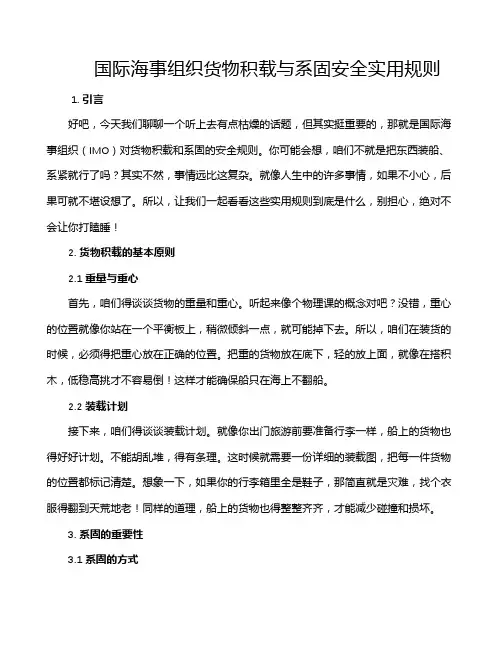
国际海事组织货物积载与系固安全实用规则1. 引言好吧,今天我们聊聊一个听上去有点枯燥的话题,但其实挺重要的,那就是国际海事组织(IMO)对货物积载和系固的安全规则。
你可能会想,咱们不就是把东西装船、系紧就行了吗?其实不然,事情远比这复杂。
就像人生中的许多事情,如果不小心,后果可就不堪设想了。
所以,让我们一起看看这些实用规则到底是什么,别担心,绝对不会让你打瞌睡!2. 货物积载的基本原则2.1 重量与重心首先,咱们得谈谈货物的重量和重心。
听起来像个物理课的概念对吧?没错,重心的位置就像你站在一个平衡板上,稍微倾斜一点,就可能掉下去。
所以,咱们在装货的时候,必须得把重心放在正确的位置。
把重的货物放在底下,轻的放上面,就像在搭积木,低稳高挑才不容易倒!这样才能确保船只在海上不翻船。
2.2 装载计划接下来,咱们得谈谈装载计划。
就像你出门旅游前要准备行李一样,船上的货物也得好好计划。
不能胡乱堆,得有条理。
这时候就需要一份详细的装载图,把每一件货物的位置都标记清楚。
想象一下,如果你的行李箱里全是鞋子,那简直就是灾难,找个衣服得翻到天荒地老!同样的道理,船上的货物也得整整齐齐,才能减少碰撞和损坏。
3. 系固的重要性3.1 系固的方式然后,我们得说说系固。
俗话说:“不怕一万,就怕万一。
”虽然船在水上漂,但货物不能跟着水流四处游荡!得把它们牢牢地固定住。
一般来说,可以用绳索、链条和支架等方式进行系固。
每一种方式都有自己的“拿手绝活”,比如绳索灵活,但链条更结实。
选择合适的系固方式,就像找对象,合适才是最重要的嘛!3.2 定期检查再来,就是要定期检查系固情况。
谁也不想在航行中突然听到“咔嚓”一声,那可就完蛋了!就像你得时不时检查一下你的汽车轮胎,确保它们没问题。
船长和船员们也得定期检查货物的系固情况,确保一切安好。
毕竟,平安最重要,万一出事了,得不偿失啊!4. 总结最后,咱们再来总结一下。
国际海事组织的货物积载与系固安全规则,看似简单,但里面的学问可不少。
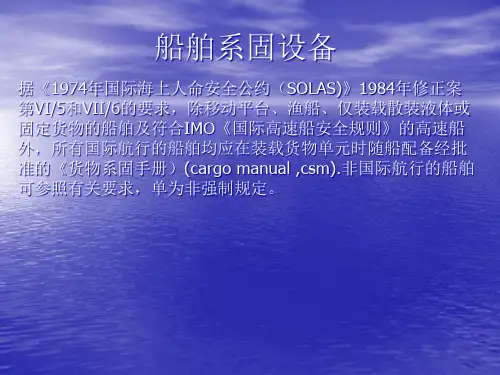
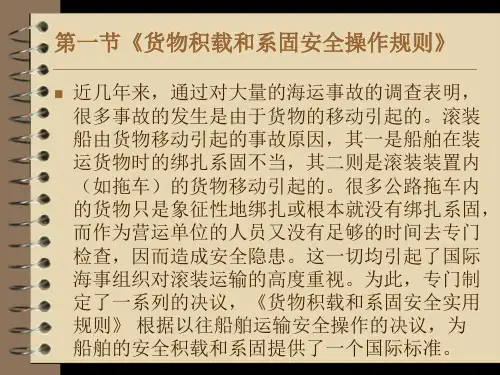
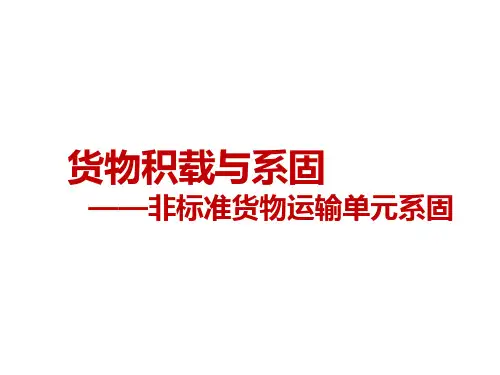
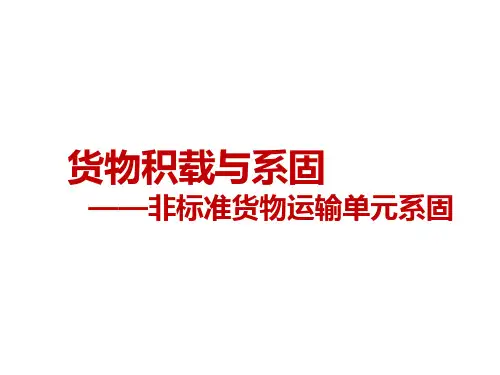
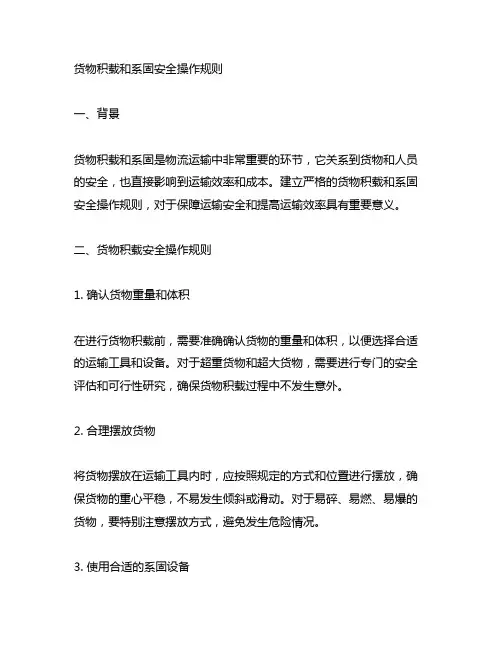
货物积载和系固安全操作规则一、背景货物积载和系固是物流运输中非常重要的环节,它关系到货物和人员的安全,也直接影响到运输效率和成本。
建立严格的货物积载和系固安全操作规则,对于保障运输安全和提高运输效率具有重要意义。
二、货物积载安全操作规则1. 确认货物重量和体积在进行货物积载前,需要准确确认货物的重量和体积,以便选择合适的运输工具和设备。
对于超重货物和超大货物,需要进行专门的安全评估和可行性研究,确保货物积载过程中不发生意外。
2. 合理摆放货物将货物摆放在运输工具内时,应按照规定的方式和位置进行摆放,确保货物的重心平稳,不易发生倾斜或滑动。
对于易碎、易燃、易爆的货物,要特别注意摆放方式,避免发生危险情况。
3. 使用合适的系固设备在货物积载过程中,需要使用合适的系固设备对货物进行固定,防止在运输过程中发生移动或脱落。
系固设备的选择应根据货物的特性和运输工具的结构进行合理搭配,确保系固效果和安全性。
4. 定期检查和维护货物积载后,需要定期对系固设备和货物进行检查和维护,发现问题及时进行修复或更换,确保系固装置的稳固性和可靠性。
三、系固安全操作规则1. 系固点的选择在进行系固操作前,需要选择合适的系固点,确保系固设备能够有效地固定货物。
系固点的选择应考虑到固定点的结构可靠性和载荷能力,避免选择损坏或失效的系固点。
2. 系固设备的正确使用进行系固操作时,应按照规定的步骤和方法操作系固设备,确保系固操作的正确性和有效性。
在系固过程中,应注意系固设备的张紧度和稳定性,避免造成系固松动或脱落。
3. 对系固设备的检查对于已安装的系固设备,需要定期进行检查,确保系固设备没有损坏或老化。
发现问题时,应及时更换或修复系固设备,避免在运输过程中产生安全隐患。
4. 遵守安全操作规程在进行系固操作时,要遵守相应的安全操作规程,严禁超载或随意更改系固方式。
要遵循运输工具的载重要求和系固标准,确保系固操作符合规定和标准。
四、结语货物积载和系固操作规则的建立和执行,对于保障物流运输安全和提高运输效率具有重要意义。
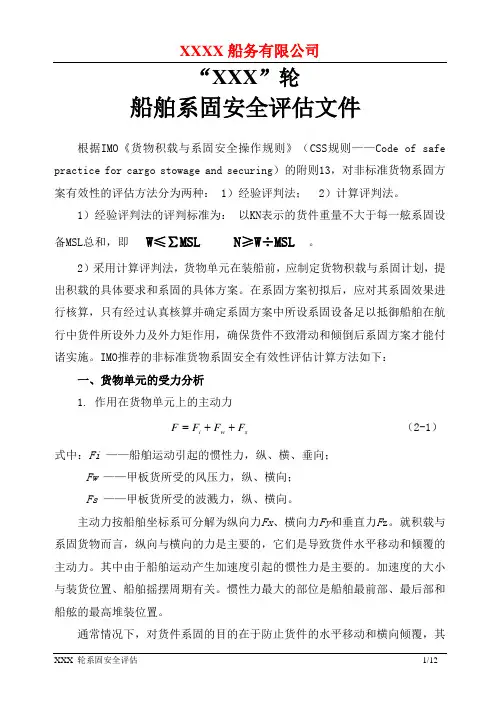
“XXX ”轮船舶系固安全评估文件根据IMO 《货物积载与系固安全操作规则》(CSS 规则——Code of safe practice for cargo stowage and securing )的附则13,对非标准货物系固方案有效性的评估方法分为两种: 1)经验评判法; 2)计算评判法。
1)经验评判法的评判标准为: 以KN 表示的货件重量不大于每一舷系固设备MSL 总和,即 W ≤∑MSL N ≥W ÷MSL 。
2)采用计算评判法,货物单元在装船前,应制定货物积载与系固计划,提出积载的具体要求和系固的具体方案。
在系固方案初拟后,应对其系固效果进行核算,只有经过认真核算并确定系固方案中所设系固设备足以抵御船舶在航行中货件所设外力及外力矩作用,确保货件不致滑动和倾倒后系固方案才能付诸实施。
IMO 推荐的非标准货物系固安全有效性评估计算方法如下:一、货物单元的受力分析 1. 作用在货物单元上的主动力s w i F F F F ++=(2-1)式中:Fi ——船舶运动引起的惯性力,纵、横、垂向;Fw ——甲板货所受的风压力,纵、横向; Fs ——甲板货所受的波溅力,纵、横向。
主动力按船舶坐标系可分解为纵向力Fx 、横向力Fy 和垂直力F z 。
就积载与系固货物而言,纵向与横向的力是主要的,它们是导致货件水平移动和倾覆的主动力。
其中由于船舶运动产生加速度引起的惯性力是主要的。
加速度的大小与装货位置、船舶摇摆周期有关。
惯性力最大的部位是船舶最前部、最后部和船舷的最高堆装位置。
通常情况下,对货件系固的目的在于防止货件的水平移动和横向倾覆,其垂向移动(垂跃)和纵向倾覆的可能性极小而一般不予考虑。
2. 作用在货物单元上的约束力约束力与货件移动方向相反,由系索提供的系固力和货件与甲板间的摩擦力两部分组成。
按船舶坐标系可分解为纵滑约束力[Fx]、横滑约束力[Fy]、垂跃约束力[Fz]。
二、评估计算方法1. 系索强度1)破断强度BS设备在拉伸试验中使其达到破断状态时的拉力(kN)。
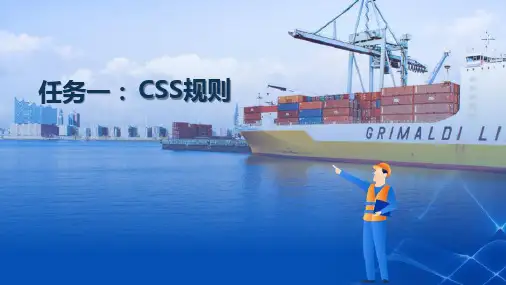
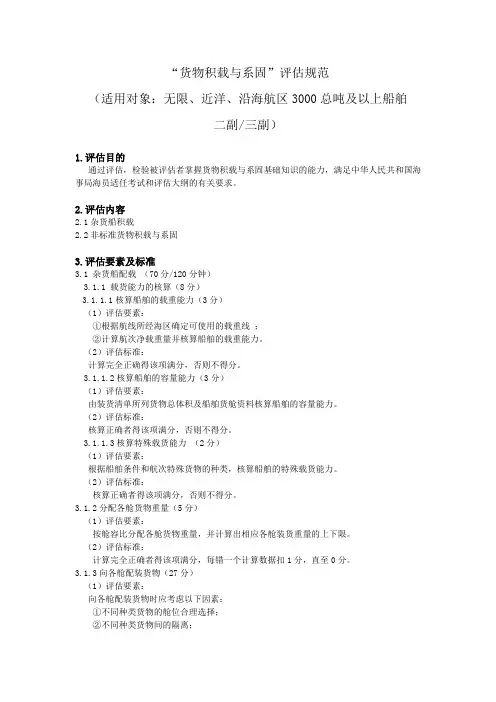
“货物积载与系固”评估规范(适用对象:无限、近洋、沿海航区3000总吨及以上船舶二副/三副)1.评估目的通过评估,检验被评估者掌握货物积载与系固基础知识的能力,满足中华人民共和国海事局海员适任考试和评估大纲的有关要求。
2.评估内容2.1杂货船积载2.2非标准货物积载与系固3.评估要素及标准3.1 杂货船配载(70分/120分钟)3.1.1 载货能力的核算(8分)3.1.1.1核算船舶的载重能力(3分)(1)评估要素:①根据航线所经海区确定可使用的载重线;②计算航次净载重量并核算船舶的载重能力。
(2)评估标准:计算完全正确得该项满分,否则不得分。
3.1.1.2核算船舶的容量能力(3分)(1)评估要素:由装货清单所列货物总体积及船舶货舱资料核算船舶的容量能力。
(2)评估标准:核算正确者得该项满分,否则不得分。
3.1.1.3核算特殊载货能力(2分)(1)评估要素:根据船舶条件和航次特殊货物的种类,核算船舶的特殊载货能力。
(2)评估标准:核算正确者得该项满分,否则不得分。
3.1.2分配各舱货物重量(5分)(1)评估要素:按舱容比分配各舱货物重量,并计算出相应各舱装货重量的上下限。
(2)评估标准:计算完全正确者得该项满分,每错一个计算数据扣1分,直至0分。
3.1.3向各舱配装货物(27分)(1)评估要素:向各舱配装货物时应考虑以下因素:①不同种类货物的舱位合理选择;②不同种类货物间的隔离;③货物装卸及安全作业的考虑;④各货舱配货重量和体积的考虑;⑤船舶性能的考虑。
(2)评估标准:①完全符合以上原则得27分;②较小错误每一处扣2分;③一般性错误每一处扣4分;④较严重性错误每处扣8分;⑤货物整体配装较差者,以本项目评估成绩不及格论。
3.1.4全面检查初配方案(5分)(1)评估要素:按上述货物配装所考虑的因素对初配方案进行核查;①填写重量、体积核查表,核查其各货舱配货重量及体积的可靠性、准确性;②校核实际负荷较大处的甲板局部强度。
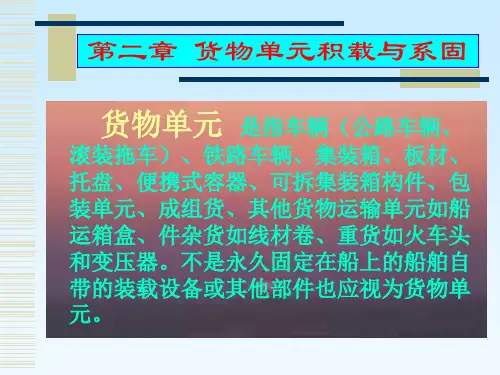
中华人民共和国海事局关于发布新版《编制<货物系固手册>导则》及有关问题的通知【法规类别】船舶【发文字号】海船舶[2006]2号【发布部门】中华人民共和国海事局【发布日期】2006.01.04【实施日期】2006.01.04【时效性】现行有效【效力级别】部门规范性文件中华人民共和国海事局关于发布新版《编制<货物系固手册>导则》及有关问题的通知(海船舶[2006]2号)各直属海事局:为了确保我国国际航行船舶能够满足相关国际公约的要求,我局根据《1974年国际海上人命安全公约》(SOLAS74)1994年修正案及IMO《货物积载和系固安全操作规则》的有关要求,于1997年制定并颁布了《编制<货物系固手册>导则》(港监字[1997]337号)以便各船公司为其所属船舶编制94年修正案强制要求配备的《货物系固手册》。
上述导则的颁布对统一《手册》的编制标准,确保中国籍国际航行船舶在94修正案生效前满足公约的具体要求,以保障船舶安全营运起到了重要作用。
但自94修正案于1998年1月1日生效之日起,国际海事组织对《货物积载和系固安全操作规则》进行了多次修改,原《规则》的部分重要内容发生了变化,继续依照该《规则》及原编制导则对船舶的系固手册进行审批,已不能完全保证船载货物的安全积载和系固。
因此,我局在搜集整理2004年12月底前相关修正案的基础上,制定了新版的《编制<货物系固手册>导则》(附件一,以下简称“导则”),现予发布,并就有关问题通知如下:一、从发文之日起,凡中国籍国际航行船舶编制《货物系固手册》均应按照本《导则》要求编写,船舶现有的《货物系固手册》应在2006年12月1日前依据本《导则》完成相应的修订工作并根据《国际航行船舶<货物系固手册>审批规定》(港监字[1997]316号)(以下简称“审批规定”)的要求向有关海事管理机构提出重新审批的申请。
各级海事主管机关应严格按照本《导则》对上述经编写或修订的《货物系固手册》进行审批。
CODE OF SAFE PRACTICE FOR CARGO STOWAGE AND SECURINGIMO LONDON 1992PrefaceUpon instructions by the Maritime Safety Committee (MSC) the SubCommittee on Containers and Cargoes developed the Code of Safe Practice for Cargo Stowage and Securing. The Code was approved by theCommittee at its fifty-eighth session (May 1990) and adopted by the Assembly at its seventeenth regular session (November 1991) by resolution A.714(17).The Assembly recommended that Governments implement the Code at the earliest possible opportunity and requested the MSC to keep it under review and amend it, as necessary.The present edition of the Code includes, as appendices, various texts which have been issued by the Organization and are considered relevant to cargo stowage and securing. Any amendments or revisions which may be made in future will be included in subsequent editions of the Code.Resolution A.714(17)(adopted 6 November 1991)THE ASSEMBLY,RECALLING Article 15(j) of the Convention on the International Maritime Organization concerning the functions of the Assembly in relation to regulations and guidelines concerning maritime safety,RECALLING ALSO resolution A.489(Xll) on safe stowage and securing of cargo units and other entities in ships other than cellular containerships and MSC/Circ.385 of January 1985 containing the provisions to be included in a cargo securing manual to be carried on board ships,RECALLING FURTHER resolution A.533(13) on elements to be taken into account when considering the safe stowage and securing of cargo units and vehicles in ships,CONSIDERING the revised IMO/lLO Guidelines for Packing Cargo in Freight Containers or Vehicles,CONSIDERING ALSO resolution A.581(14) on guidelines for securing arrangements for the transport of road vehicles on ro—ro ships,BEARING IN MIND that a number of serious accidents have occurred as a result of inadequate securing arrangements on board and deficient stowage and securing of cargoes in vehicles and containers, and that only proper stowage and securing of cargo on adeqately designed and properly equipped ships can prevent the occurrence of such accidents in the future,RECOGNIZING the need to improve the stowage and securing of cargoes shown by experience to create specific hazards to the safety of ships, and the stowage and securing of road vehicles transported on board ro—ro ships,RECOGNIZING FURTHER that such improvement could be achieved by the establishment of a composite code of safe practice for cargo stowage and securing on board ships, including packing or loading cargo in road vehicles and freight containers,BELIEVING that the application of such a code of safe practice would enhance maritime safety,HA VING CONSIDERED the recommendations made by the Maritime Safety Committee at its fifty-eighth session,1. ADOPTS the Code of Safe Practice for Cargo Stowage and Securing set out in the annex to the present resolution;2. URGES Governments to implement this Code at the earliest possible opportu nity;3. REQUESTS the Maritime Safety Committee to keep this Code under review and to amend it, as necessary;4. REVOKES resolution A.288(VIll).AnnexCode of Safe Practice forCargo Stowage and SecuringFOREWORDThe proper stowage and securing of cargoes is of the utmost importance for the safety of life at sea. Improper stowage and securing of cargoes has resulted in numerous serious ship casualties and caused injury and loss of life, not only at sea but also during loading and discharge.In order to deal with the problems and hazards arising from improper stowage and securing of certain cargoes on ships, the International Maritime Organization (IMO) has issued guidelines in the form of either Assembly resolutions or circulars adopted by the Maritime Safety Committee (MSC); these are listed hereunder:• Safe stowage and securing of cargo units and other entities in ships other than cellular containerships, resolution A.489(Xll) [see appendix 1];• Provisions to be included in the Cargo Securing Manual to be carried on board ships, MSC/Circ.385 [see appendix 2];• Elements to be taken into account when considering the safe stowage and securing of cargo units and vehicles in ships, resolution A.533(13) [see appendix 3];• Guidelines for Securing Arrangements for the Transport of Road Vehicles on Ro—Ro Ships, resolution A.581(14) [see appendix 4];• IMO/lLO Guidelines for Packing Cargo in Freight Containers or Vehicles [see lMO publication sales number lMO-28.4E (same title) or the Supplement to the IMDG Code (sales number lMO-210E)];• Entry into enclosed spaces, MSC/Circ.487 [see appendix 5].The accelerations acting on a ship in a seaway result from a combination of longitudinal, vertical and predominantly transverse motions. The forces created by these accelerations give rise to the majority of securing problems.The hazards arising from these forces should be dealt with by taking measures both to ensure proper stowage and securing of cargoes on board and to reduce the amplitude and frequency of ship motions.The purpose of this Code is to provide an international standard to promote the safe stowage and securing of cargoes by:• drawing the attention of shipowners and ship operators to the need to ensure that the ship is suitable for its intended purpose;• providing advice to ensure that the ship is equipped with proper cargo securing means;• providing general advice concerning the proper stowage and securing of cargoes to minimize the risks to the ship and personnel;• providing specific advice on those cargoes which are known to create difficulties and hazards with regard to their stowage and securing;• advising on actions which may be taken in heavy sea conditions; and• advising on actions which may be taken to remedy the effects of cargo shifting.In providing such advice, it should be borne in mind that the master is responsible for the safe conduct of the voyage and the safety of the ship, its crew and its cargo.GENERAL PRINCIPLESAll cargoes should be stowed and secured in such a way that the ship and persons on board are not put at risk.The safe stowage and securing of cargoes depend on proper planning, execution and supervision.Personnel commissioned to tasks of cargo stowage and securing should be properly qualified and experienced.Personnel planning and supervising the stowage and securing of cargo should have a sound practical knowledge of the application and content of the Cargo Securing Manual, if provided.In all cases, improper stowage and securing of cargo will be potentially hazardous to the securing of other cargoes and to the ship itself.Decisions taken for measures of stowage and securing cargo should be based on the most severe weather conditions which may be expected by experience for the intended voyage.Ship-handling decisions taken by the master, especially in bad weather conditions, should take into account the type and stowage position of the cargo and the securing arrangements.CHAPTER 1 - GENERAL1.1 A pplicationThis Code applies to cargoes carried on board ships (other than solid and liquid bulk cargoes and timber stowed on deck) and, in particular, to those cargoes whose stowage and securing have proved in practice to create difficulties.1.2 D efinitions of the terms used For the purposes of this Code:Cargo unit means a vehicle, container, flat, pallet, portable tank, packaged unit, or any other entity, etc., and loading equipment, or any part thereof, which belongs to the ship but is not fixed to the ship as defined in Assembly resolution A.489(Xlt). Intermediate bulk container (1BC) means a rigid, semi-rigid or flexible portable bulk container packaging of a capacity of not more than 3 m3 (3,000 1), designed for mechanical handling and tested for its satisfactory resistance to handling andtransport stresses.Portable tank means a tank which is not permanently secured on board a ship, and has a capacity of more than 450 1 and a shell fitted with external stabilizing members and items of service equipment and structural equipment necessary for the transport of gases, liquids or solids.Road tank-vehicle means a vehicle with wheels and fitted with a tank or tanks intended for the transport of gases, liquids or solids by both road and sea modes of transport, the tank or tanks of which are rigidly and permanently attached to the vehicle during all normal operations of loading, transport and discharge and are neither filled nor emptied on board.Road vehicle means a commercial vehicle, semi-trailer, road train, articulated road train or a combination of vehicles, as defined in Assembly resolution A.581(14).Roll-trailer means a low vehicle for the carriage of cargo with one or more wheel axles on the rear and a support on the front end, which is towed or pushed in the port to and from its stowage on board the ship by a special tow-vehicle.Ro-ro ship means a ship which has one or more decks either closed or open, not normally subdivided in any way and generally running the entire length of the ship, carrying goods which are loaded and unloaded normally in a horizontal manner.Unit load means that a number of packages are either:.1 placed or stacked, and secured by strapping, shrink-wrapping or other suitable means, on to a load board such as a pallet; or.2 placed in a protective outer packaging such as a pallet box; or.3 permanently secured together in a sling.1.3 F orces1.3.1 Forces, which have to be absorbed by suitable arrangements for stowage and securing to prevent cargo shifting, are generally composed of components acting relative to the axes of the ship:• longitudinal;• transverse; and• vertical.Remark: For the purpose of stowage and securing cargo, longitudinal and transverse forces are considered predominant.1.3.2 Transverse forces alone, or the resultant of transverse, longitudinal and vertical forces, normally increase with the height of the stow and the longitudinal distance of the stow from the ship’s centre of motion in a seaway. The most severeforces can be expected in the furthest forward, the furthest aft and the highest stowage position on each side of the ship.1.3.3 The transverse forces exerted increase directly with the metacentric height of the ship. An undue metacentric height may be caused by:• improper design of the ship;• unsuitable cargo distribution; and• unsuitable bunker and ballast distribution.1.3.4 Cargo should be so distributed that the ship has a metacentric height in excess of the required minimum and, whenever practicable, within an acceptable upper limit to minimize the forces acting on the cargo.1.3.5 In addition to the forces referred to above, cargo carried on deck may be subjected to forces arising from the effects of wind and green seas.1.3.6 Improper shiphandling (course or speed) may create adverse forces acting on the ship and the cargo.1.3.7 The magnitude of the forces may be estimated by using the appropriate calculation methods as contained in the Cargo Securing Manual, if provided.1.3.8 Although the operation of anti-roll devices may improve the behaviour of the ship in a seaway, the effect of such devices should not be taken into account when planning the stowage and securing of cargoes.1.4 B ehaviour of cargoes1.4.1 Some cargoes have a tendency to deform or to compact themselves during the voyage, which will result in a slackening of their securing gear.1.4.2 Cargoes with low friction coefficients, when stowed without proper friction-increasing devices such as dunnage, soft boards, rubber mats, etc., are difficult to secure unless tightly stowed across the ship.1.5 C riteria for estimating the risk of cargo shifting1.5.1 When estimating the risk of cargo shifting, the following should be considered:• dimensional and physical properties of the cargo;• location of the cargo and its stowage on board;• suitability of the ship for the particular cargo;• suitability of the securing arrangements for the particular cargo;• expected seasonal weather and sea conditions;• expected ship behaviour during the intended voyage;• stability of the ship;• geographical area of the voyage; and• duration of the voyage.1.5.2 These criteria should be taken into account when selecting suitable stowage and securing methods and whenever reviewing the forces to be absorbed by the securing equipment.1.5.3 Bearing in mind the above criteria, the master should accept the cargo on board his ship only if he is satisfied that it can be safely transported.1.6 C argo Securing Manual1.6.1 Ships carrying cargo units and other entities covered in this Code and as outlined in resolution A.489(XIl) (appendix) should carry a Cargo Securing Manual as detailed in MSC/Circ.385.*1.6.2 The cargo securing arrangements detailed in the ship’s Cargo Securing Manual, if provided, should be based on the forces expected to affect the cargo carried by the ship, calculated in accordance with a method accepted by the Administration or approved by a classification society acceptable to the Administration.1.7 E quipmentThe ship’s cargo securing equipment should be:• available in sufficient quantity;• suitable for its intended purpose, taking into account the recom-mendations of the Cargo Securing Manual, if provided;• of adequate strength;• easy to use; and• well maintained.1.8 S pecial cargo transport unitsThe shipowner and the ship operator should, where necessary, make use of relevant expertise when considering the shipment of a cargo with unusual characteristics which may require special attention to be given to its location on board vis-а-vis the structural strength of the ship, its stowage and securing, and the weather conditions which may be expected during the intended voyage.1.9 C argo information1.9.1 Before accepting a cargo for shipment, the shipowner or ship operator should obtain all necessary information about the cargo and ensure that:• the different commodities to be carried are compatible with each other or suitably separated;• the cargo is suitable for the ship;• the ship is suitable for the cargo; and• the cargo can be safely stowed and secured on board the ship and transported under all expected conditions during the intended voyage.1.9.2 The master should be provided with adequate information regarding the cargo to be carried so that its stowage may be properly planned for handling and transport.CHAPTER 2 - PRINCIPLES OF SAFE STOWAGEAND SECURING OF CARGOES2.1 S uitability of cargo for transportCargo carried in containers, road vehicles, shipborne barges, railway wagons and other cargo transport units should be packed and secured within these units so as to prevent, throughout the voyage, damage or hazard to the ship, to the persons on board and to the marine environment.2.2 C argo distribution2.2.1 It is of utmost importance that the master takes great care in planning and supervising the stowage and securing of cargoes in order to prevent cargo sliding, tipping, racking, collapsing, etc.2.2.2 The cargo should be distributed so as to ensure that the stability of the ship throughout the entire voyage remains within acceptable limits so that the hazards of excessive accelerations are reduced as far as practicable.2.2.3 Cargo distribution should be such that the structural strength of the ship is not adversely affected.2.3 C argo securing arrangements2.3.1 Particular care should be taken to distribute forces as evenly as practicable between the cargo securing devices. If this is not feasible, the arrangements should be upgraded accordingly.2.3.2 If, due to the complex structure of a securing arrangement or other circumstances, the person in charge is unable to assess the suitability of the arrangement from experience and knowledge of good seamanship, the arrangement should be verified by using an acceptable calculation method.2.4 R esidual strength after wear and tearCargo securing arrangements and equipment should have sufficient residual strength to allow for normal wear and tear during their lifetime.2.5 F riction forcesWhere friction between the cargo and the ship’s deck or structure or between cargo transport units is insufficient to avoid the risk of sliding, suitable material such as soft boards or dunnage should be used to increase friction.2.6 S hipboard supervision2.6.1 The principal means of preventing the improper stowage and securing of cargoes is through proper supervision of the loading operation and inspections of the stow.2.6.2 As far as practicable, cargo spaces should be regularly inspected throughout the voyage to ensure that the cargo, vehicles and cargo transport units remain safely secured.2.7 E ntering enclosed spacesThe atmosphere in any enclosed space may be incapable of supporting human life through lack of oxygen or it may contain flammable or toxic gases. The master should ensure that it is safe to enter any enclosed space.2.8 G eneral elements to be considered by the masterHaving evaluated the risk of cargo-shifting, taking into account the criteria set out in1.5, the master should ensure, prior to loading of any cargo, cargo transport unit or vehicle that:.1 the deck area for their stowage is, as far as practicable, clean, dry and free from oil and grease;.2 the cargo, cargo transport unit or vehicle appears to be in suitable condition for transport, and can be effectively secured;.3 all necessary cargo securing equipment is on board and in good working condition; and.4 cargo in or on cargo transport units and vehicles is, to the extent practicable, properly stowed and secured on to the unit or vehicle.2.9 C argo stowage and securing declaration2.9.1 Where there is reason to suspect that a container or vehicle into which dangerous goods have been packed or loaded is not in compliance with the provisions of section 12 or 17, as appropriate, of the General Introduction to the IMDG Code, or where a container packing certificate! vehicle packing declaration is not available, the unit should not be accepted for shipment.2.9.2 Where practicable and feasible, road vehicles should be provided with a cargo stowage and securing declaration, stating that the cargo on the road vehicle has been properly stowed and secured for the intended sea voyage, taking into account the IMO/ILO Guidelines for Packing Cargo in Freight Containers or Vehicles. An example of such a declaration is given hereunder. The vehicle packing declaration, recommended by the IMDG Code (see 2.9.1), may be acceptable for this purpose.CHAPTER 3 - STANDARDIZED STOWAGE AND SECURING SYSTEMS 3.1 R ecommendationsShips intended for the carriage of cargoes in a standardized stowage and securing system (e.g. containers, railway wagons, shipborne barges, etc.) should be:.1 so designed and equipped that the standardized cargoes concerned can be safely stowed and secured on board under all conditions expected during the intended voyage;.2 of a design and so equipped as to be accepted by the Administration or approved by a classification society acceptable to the Administration; and.3 provided with adequate information, for use by the master, on the arrangements provided for the safe stowage and securing of the specific cargoes for which the ship is designed or adapted.CHAPTER 4- SEMI-STANDARDIZED STOWAGE AND SECURING4.1 S ecuring arrangements4.1.1 Ships intended for the carriage of certain specific cargoes such as road vehicles, systemized cargo-carrying roll-trailers and automobiles on ro-ro ships, etc., should be provided with securing points spaced sufficiently close to each other for the intended operation of the ship and in accordance with section 4 of the guidelines for securing arrangements for the transport of road vehicles on ro—ro ships (resolution A.581(14)).4.1.2 Road vehicles intended for transport by sea should be provided with arrangements for their safe stowage and securing, as detailed in section 5 of the annex to resolution A.581(14).4.1.3 Roll-trailers carrying systemized cargo should be provided with arrangements for the safe stowage and securing of the vehicle and its cargo. Special consideration should be given to the height of the stow, the compactness of the stow and the effects of a high centre of gravity of the cargo.4.2 S towage and securing of vehicles4.2.1 Vehicles, including roll-trailers not provided with adequate securing arrangements, should be stowed and secured in accordance with chapter 5 of this Code.4.2.2 Ro-ro ships which do not comply with the requirements of section 4 of the annex to resolution A.581 (14) or are not provided with equivalent stowage andsecuring means providing for an equivalent degree of safety during transport by sea should be dealt with in accordance with chapter 5 of this Code.4.2.3 Vehicles should be stowed and secured in accordance with sections 6 and 7 of the annex to resolution A.581 (14). Special consideration should be given to the stowage and securing of roll-trailers carrying systemized cargo, road tank-vehicles and portable tanks on wheels, taking into account the effects of a tank’s high centre of gravity and free surface.4.3 A cceptance of road vehicles for transport by sea on ro—ro ships4.3.1 The master should not accept a road vehicle for transport on board his ship unless satisfied that the road vehicle is apparently suitable for the intended voyage and is provided with at least the securing points specified in section 5 of the annex to resolution A.581(14).4.3.2 In exceptional circumstanceS, where there is some doubt that the recommendations of 4.3.1 can or need to be fulfilled, the master may accept the vehicle for shipment, after taking into account the condition of the vehicle and the expected nature of the intended voyage.CHAPTER 5 - NON-STANDARDIZED STOWAGE AND SECURING5.1 R ecommendations5.1.1 This chapter and the annexes provide advice of a general nature for the stowage and securing of cargoes not covered by chapters 3 and 4 of this Code and particularly specific advice for the stowage and securing of cargoes which have proved to be difficult to stow and secure on board ships.5.1.2 The list of cargoes given in 5.3 should not be regarded as exhaustive, as there may be other cargoes which could create hazards if not properly stowed and secured.5.2 E quivalent stowage and securingThe guidance given in the annexes provides for certain safeguards against the problems inherent in the cargoes covered. Alternative methods of stowage and securing may afford the same degree of safety. It is imperative that any alternative method chosen should provide a level of securing safety at least equivalent to that described in the resolutions, circulars and guidelines listed in the foreword to this Code.5.3 C argoes which have proved to be a potential source of dangerSuch cargoes include:.1 containers when carried on deck of ships which are not specially designed and fitted for the purpose of carrying containers (annex 1);.2 portable tanks (tank-containers) (annex 2);.3 portable receptacles (annex 3);.4 special wheel-based (rolling) cargoes (annex 4);.5 heavy cargo items such as locomotives, transformers, etc. (annex 5);.6 coiled sheet steel (annex 6);.7 heavy metal products (annex 7);.8 anchor chains (annex 8);.9 metal scrap in bulk (annex 9);.10 f lexible intermediate bulk containers (FIBCs) (annex 10);.11 logs in under-deck stow (annex 11); and.12 u nit loads (annex 12).CHAPTER 6- ACTIONS WHICH MAY BE TAKEN IN HEAVY WEATHER 6.1 G eneralThe purpose of this chapter is not to usurp the responsibilities of the master, but rather to offer some advice on how stresses induced by excessive accelerations caused by bad weather conditions could be avoided.6.2 Excessive accelerationsMeasures to avoid excessive accelerations are:.1 alteration of course or speed or a combination of both;.2 heaving to;.3 early avoidance of areas of adverse weather and sea conditions; and.4 timely ballasting or deballasting to improve the behaviour of the ship, taking into account the actual stability conditions (see also 7.2).6.3 Voyage planningOne way of reducing excessive accelerations is for the master, as far as possible and practicable, to plan the voyage of the ship carefully so as to avoid areas with severe weather and sea conditions. The master should always consult the latest available weather information.CHAPTER 7- ACTIONS WHICH MAY BE TAKEN ONCE CARGO HAS SHIFTED7.1 T he following actions may be considered:.1 alterations of course to reduce accelerations;.2 reductions of speed to reduce accelerations and vibration;.3 monitoring the integrity of the ship;.4 restowing or resecuring the cargo and, where possible,increasing the friction; and.5 diversion of route in order to seek shelter or improved weather and sea conditions.7.2 T ank ballasting or deballasting operations should be considered only if the ship has adequate stability.Annex 1Safe stowage and securing of containers on deck ofships which are not specially designed and fittedfor the purpose of carrying containers1 STOWAGE1.1 C ontainers carried on deck or on hatches of such ships should preferably be stowed in the fore-and-aft direction.1.2 C ontainers should not extend over the ship’s sides. Adequate supports should be provided when containers overhang hatches or deck structures.1.3 C ontainers should be stowed and secured so as to permit safe access for personnel in the necessary operation of the ship.1.4 C ontainers should at no time overstress the deck or hatches on which they are stowed.1.5 B ottom-tier containers, when not resting on stacking devices, should be stowed on timber of sufficient thickness, arranged in such a way as to transfer the stack load evenly on to the structure of the stowage area.1.6 W hen stacking containers, use should be made of locking devices, cones, or similar stacking aids, as appropriate, between them.1.7 W hen stowing containers on deck or hatches, the position and strength of the securing points should be taken into consideration.2 SECURING2.1 A ll containers should be effectively secured in such a way as to protect them from sliding and tipping. Hatch covers carrying containers should be adequately secured to the sFip.2.2 C ontainers should be secured using one of the three methods recommended in figure 1 or methods equivalent thereto.2.3 L ashings should preferably consist of wire ropes or chains or material with equivalent strength and elongation characteristics.2.4 T imber shoring should not exceed 2 m in length.2.5 W ire clips should be adequately greased, and tightened so that the dead end of the wire is visibly compressed (figure 2).2.6 L ashings should be kept, when possible, under equal tension.Annex 2Safe stowage and securing of portable tanks1 INTRODUCTION1.1 T he provisions of this annex apply to a portable tank, which in the context of this annex, means a tank which is not permanently secured on board the vessel and has a capacity of more than 450 / and a shell fitted with external stabilizing members and items of service equipment and structural equipment necessary for the transport of liquids, solids or gases.1.2 T hese provisions do not apply to tanks intended for the transport of liquids, solids or gases having a capacity of 450 1 or less.Note: The capacity for portable tanks for gases is 1,000 1 or more.2 GENERAL PROVISIONS FOR PORTABLE TANKS2.1 P ortable tanks should be capable of being loaded and discharged without the need of removal of their structural equipment and be capable of being lifted onto and off the ship when loaded.2.2 T he applicable requirements of the International Convention for Safe Containers, 1972, as amended, should be fulfilled by any tank-container which meets the definition of a container within the terms of that Convention. Additionally, the provisions of section 13 of the General Introduction to the IMDG Code should be met when the tank will be used for the transport of dangerous goods.2.3 P ortable tanks should not be offered for shipment in an ullage condition liable to produce an unacceptable hydraulic force due to surge within the tank.。
MSC/Circ.664(1994年12月22日)货物积载与系固安全操作规则(CSS规则)修正案海上安全委员会在其64次会议上(1994年12月5日至9日),按照大会决议A.714(17)的执行条款3,通过了所附的《货物积载与系固安全操作规则》(CSS规则)的修正案。
要求各成员国政府将上述修正案通知船东、船舶经营人、船长和船员及所有其他有关人员。
附件《货物积载与系固安全操作规则》修正案1. 第1章1.9.1条款的第1句由下述文字取代:“装货前货主应提供货物的所有必要资料以使船东或船舶经营人能保证”。
2. 第2章2.9.1条款由下述文字取代:“2.9.1 当有理由怀疑装载了危险品的集装箱或车辆不符合修正的1974年SOLAS公约第Ⅶ章5.2或5.3条款,或国际危规总则第12章或第17章的条款,或者当集装箱或车辆无装箱证书时,该宗货物件不得接受装船。
”3. 附则6的3.2条款由如下文字取代:“3.2 绑扎可为采用钢丝绳、钢带或任何等效措施的常规型绑扎。
”4. 增加新的附则13,如附录所示。
附录附则13对非标准货物绑扎装置有效性的评估方法1. 适用范围本附则介绍的方法适用于非标准货物,不适用于集装箱船上的集装箱。
按照《货物积载与系固安全操作规则》(以下简称“规则”)第1.8章条款载运的非常沉重的货件和规则附则已给出关于装载和绑扎的详尽建议的其他货物,不包括在本附则范围内。
如果计算机软机输出的设计参数满足本附则的最小安全系数要求时,则允许使用该软件。
使用本附则介绍的方法是对良好航海技术的基本原理的有益补充,不得取代积载和系固方面的经验。
2. 方法的目的该方法将:.1 给出了起草《货物系固手册》的指南和其中的例子;.2 辅助船员对《货物系固手册》范围以外的货物件进行系固的评估;.3 协助有资历的岸上人员对《货物系固手册》范围以外的货物件进行系固的评估;和.4 为海运和港务有关的教育和培训提供参考。
3. 方法的展示本方法以普遍适用且灵活的方式给出。